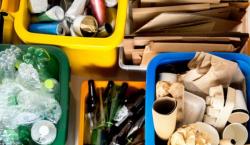Top Tips for Transitioning to a Circular Economy
August 2025
 The concept of a circular economy is reshaping how we think about resources, waste, and sustainability. Moving away from the traditional model of take-make-dispose, a circular economy aims to keep materials in use for as long as possible, extracting maximum value before recovering and regenerating products at the end of their life. This shift is essential for reducing environmental impact, conserving natural resources, and creating a more resilient economy.
The concept of a circular economy is reshaping how we think about resources, waste, and sustainability. Moving away from the traditional model of take-make-dispose, a circular economy aims to keep materials in use for as long as possible, extracting maximum value before recovering and regenerating products at the end of their life. This shift is essential for reducing environmental impact, conserving natural resources, and creating a more resilient economy.
Transitioning to a circular economy involves adopting sustainable and recyclable materials that can be reused without losing quality. For those looking to make this change, whether at an individual, business, or industry level, understanding practical steps and the benefits of materials like copper can be a powerful starting point.
Embrace Sustainable Materials with Longevity and Recyclability
A key principle of the circular economy is choosing materials that last and can be recycled endlessly. Copper is a prime example of such a material. Unlike plastic pipes, which degrade and contribute to landfill waste, copper pipes can be recycled repeatedly without any loss of quality. This makes copper an ideal choice for plumbing and electrical wiring, where durability and sustainability go hand in hand.
Copper’s long history in construction, plumbing and industry highlights its reliability and environmental credentials. Its recyclability supports a circular approach by reducing the need for virgin resource extraction and lowering energy consumption in production.
Design for Reuse and Material Recovery
Transitioning to a circular economy requires rethinking how products are designed and used. Designing for reuse means creating products and systems that can be easily repaired, refurbished, or repurposed. This approach minimises waste and keeps materials circulating within the economy.
Material recovery is equally important. Recycling materials like copper, steel, and glass reduces the demand for new raw materials and cuts down on environmental impact. Copper’s ability to be recycled endlessly without degradation makes it a standout material in this regard and a sustainable alternative to plastics that often end up as microplastic pollution.
Prioritise Waste Reduction and Resource Efficiency
Reducing waste at every stage of production and consumption is vital. This involves optimising manufacturing processes to use fewer resources and minimise scrap, as well as encouraging consumers to buy durable, repairable products instead of disposable ones.
Resource efficiency also means using materials wisely. Copper’s durability means fewer replacements and repairs are needed over time, which translates to less waste and lower environmental impact. Choosing copper pipes over plastic not only benefits water quality and health but also supports sustainability by reducing plastic waste.
Support Circular Supply Chains and Collaborative Practices
Building circular supply chains involves working closely with suppliers, manufacturers, and customers to ensure materials are sourced responsibly, products are designed for longevity, and end-of-life recovery is planned. Collaboration across industries can accelerate the transition by sharing knowledge, technology, and infrastructure.
Copper’s widespread use in various industries, from plumbing to electrical systems, exemplifies how circular supply chains can function effectively. Its recyclability and demand create a strong market for recovered materials, encouraging investment in recycling technologies and infrastructure.
Educate and Engage Communities on Circular Practices
Awareness and education are crucial for driving change. Consumers and businesses alike benefit from understanding the environmental and economic advantages of circular economy principles. Promoting the benefits of sustainable materials such as copper encourages more informed choices and fosters a culture of sustainability.
The Role of Copper in a Circular Economy
Copper is more than just a material; it is a symbol of the circular economy in action. Its natural properties such as durability, antimicrobial effects, and recyclability make it a superior choice over plastics in plumbing and electrical applications. By choosing copper, individuals and industries contribute to reducing waste, conserving resources, and supporting a sustainable future.
The transition to a circular economy is a collective effort that benefits from embracing materials like copper, which align perfectly with the goals of sustainability, resource efficiency, and waste reduction. Taking steps today to prioritise recyclable and sustainable materials will help build a resilient economy that respects the planet and its resources for generations to come.